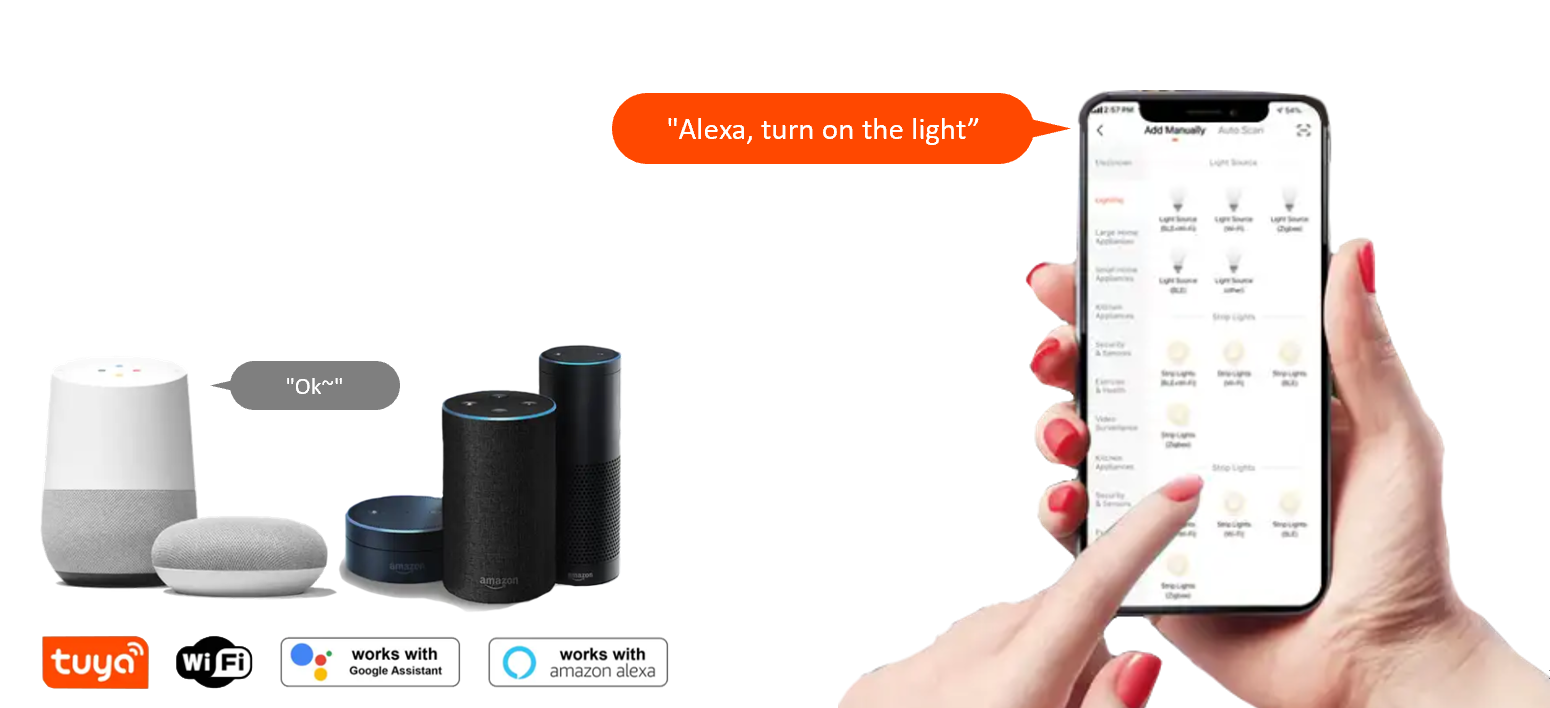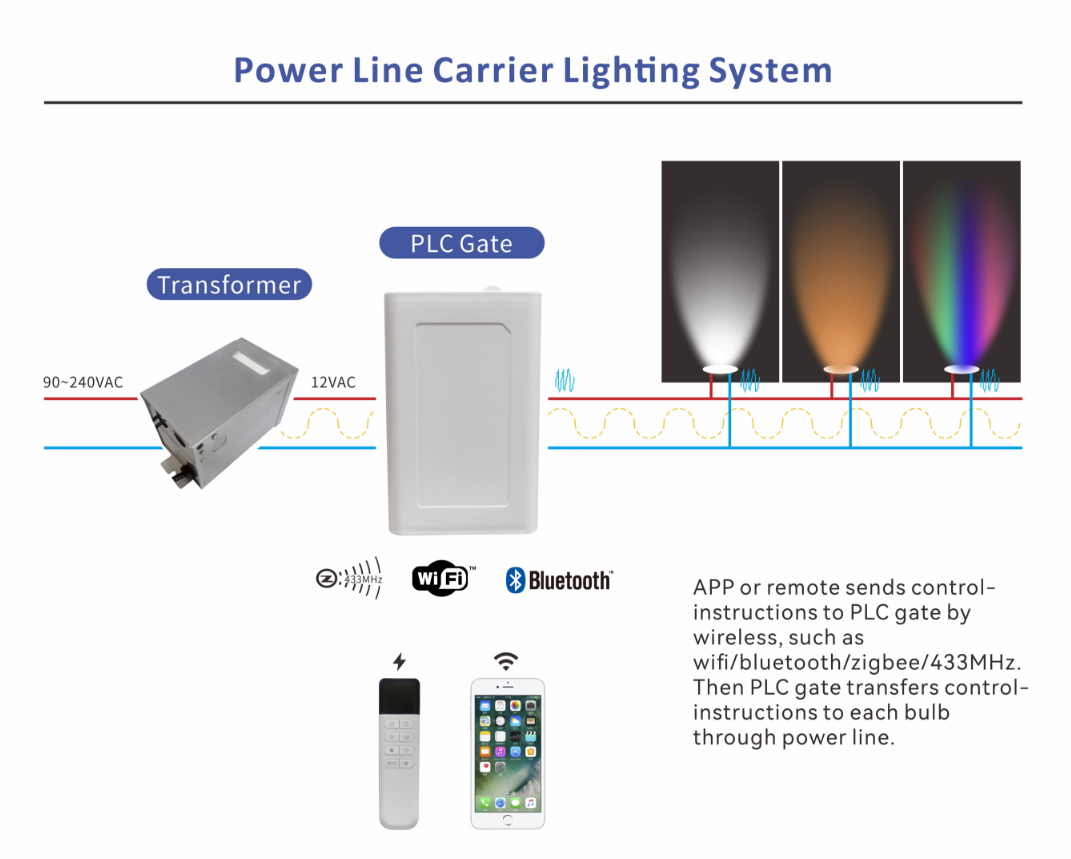Power Line Carrier Smart Control LED lighting System
Author:Admin Publish time: December 29, 2023 Origin: Site

As we all know that smart control lighting system are getting more and more popular in landscape lighting application, it can offer color-changing(RGB,CW,WW) LEDs for enhanced personalized outdoor lighting ambiance.
The main smart lighting control solutions include wireless technologies such as Wi-Fi,Bluetooth, and communication protocols like Zigbee and Z-Wave for extensive control. While these technologies offer users convenience and personalized experiences, they also come with potential issues and challenges, below are some common problems that wireless communication have.
High Cost:
Initial Investment:
Smart LED lighting systems generally require a higher upfront investment compared to traditional lighting solutions. This cost includes not only the LED fixtures themselves but also additional components like smart controllers, hubs, or gateways.
Maintenance and Upkeep:
The ongoing costs associated with maintaining and updating smart control systems can be a concern. Firmware updates, app improvements, and potential hardware malfunctions may contribute to additional expenses over time.
Complex Installation and Setup:
Technical Expertise:
Installing and setting up smart LED lighting systems may be challenging for individuals with limited technical expertise. Proper configuration of hubs, connectivity issues, and compatibility challenges can create barriers for some users.
Interoperability:
With various communication protocols (Wi-Fi, Bluetooth, Zigbee, Z-Wave) and multiple smart home platforms, ensuring seamless interoperability between different devices can be a challenge. Users may face difficulties integrating LED lights with existing smart home ecosystems.
Reliability and Connectivity:
Network Dependence:
Smart LED lighting systems heavily rely on network connectivity. Interruptions in Wi-Fi or Bluetooth connections can disrupt the functionality of the lights and may require troubleshooting.
Signal Range:
Bluetooth-based systems, in particular, may have limited signal ranges, restricting the placement of lights in larger outdoor spaces. Zigbee and Z-Wave networks can face interference issues, impacting reliability.
Security Concerns:
Cybersecurity Risks:
As with any connected device, smart LED lights are susceptible to cybersecurity threats. Weaknesses in encryption or vulnerabilities in the software can expose users to privacy and security risks.
Unauthorized Access:
Inadequately secured smart lighting systems may be vulnerable to unauthorized access. This could potentially lead to unauthorized control of the lights or other malicious activities.
Power Source Limitations:
Data Privacy Concerns:
Wireless communication Smart LED lighting systems often collect data on user preferences and usage patterns. It's essential to address concerns about how this data is handled, stored, and whether it is shared with third parties.
Opt-Out Options:
Users may be concerned about their ability to opt-out of data collection features, and the transparency of manufacturers in disclosing these practices.
Understanding and addressing these common problems associated with smart control LED lighting systems will allow you to provide valuable insights to your readers. It's essential to emphasize potential challenges while also highlighting the benefits, guiding your audience towards informed decisions based on their specific needs and preferences.
But now we developed a new technology to fulfill Smart Control lighting Technology-Power Line Carrier Smart Control LED lighting System.
Power Line Carrier (PLC) is a communication technology that uses existing electrical power lines to transmit data. Instead of dedicated communication cables, PLC utilizes the infrastructure of power lines to carry signals for communication purposes. This technology is employed in various applications, including smart grid systems, home automation, and, as mentioned earlier, in the context of smart control for LED lighting
What’s advantage for Power Line Carrier Smart Control LED lighting.
No Additional Wiring:
PLC technology eliminates the need for additional communication wiring. By utilizing existing power lines, the installation process is simplified, reducing the time, effort, and cost associated with running dedicated communication cables.
Ease of Retrofitting:
PLC-enabled LED fixtures are well-suited for retrofit projects. Users can easily upgrade their existing landscape lighting to smart control without the need for extensive rewiring.
Reliable Communication:
Stable Signal Transmission:
Power lines provide a stable and robust medium for data transmission. PLC technology ensures reliable communication between LED fixtures, minimizing the risk of signal interference or disruptions.
Extended Range:
The signal range of PLC is generally sufficient for most residential and commercial landscape lighting applications. This eliminates concerns related to the limited range often associated with wireless technologies.
Scalability:
Easy Expansion:
PLC-based systems are easily scalable. Users can add new PLC-enabled LED fixtures to their landscape lighting setup without the complexities associated with reconfiguring or expanding wireless networks.
Compatibility with Existing Infrastructure:
PLC technology can seamlessly integrate with the existing power distribution infrastructure. This makes it a practical choice for both new installations and upgrades to existing systems.
Cost-Effective:
Reduced Infrastructure Costs:
Since PLC utilizes the power lines for communication, there is a reduction in infrastructure costs associated with installing separate communication networks. This can make PLC-enabled LED lighting solutions more cost-effective compared to some wireless alternatives.
Lower Maintenance Costs:
With fewer components and no additional wiring, PLC systems may have lower maintenance costs over time. There are fewer points of failure, resulting in a more robust and durable smart lighting solution.
Enhanced Security:
Limited External Interference:
PLC technology operates within the power lines, reducing the risk of external interference compared to wireless technologies. This can contribute to a more secure and stable smart lighting system.
Reduced Cybersecurity Risks:
PLC systems may have fewer vulnerabilities to certain cybersecurity risks associated with wireless communication. This can be an important consideration for users concerned about the security of their smart lighting infrastructure.
Consistent Performance:
Minimized Signal Loss:
PLC technology tends to have minimal signal loss since the communication occurs directly over the power lines. This results in consistent performance across the entire landscape lighting setup.
Less Susceptible to Environmental Factors:
Unlike wireless systems that can be affected by environmental factors, such as radio frequency interference, PLC is less susceptible to such issues. This contributes to a more reliable and stable smart control LED lighting experience.
Mini Size, Underwater, in-ground lawn Application.
Most importantly is that Power Line Carrier can be designed to mini size Mental LED Lighting fixture, in-ground lawn, underwater lighting, which is not possible for wireless smart control, as the wireless control module is very big, impossible for some mini size LED lighting fixture and LED bulb, using smart modules inside these enclosed metal light fixtures, there may be issues with signal reception due to the metal material blocking or weakening wireless signals. This could impact the performance and stability of the smart modules, While our Power Line Carrier smart control system send data by power line, can solve all these problems.
Cost-effectively
That’s huge advantage for Power line Carrier Smart Control LED lighting system, kindly contact Shenzhen FRI lighting Technology Co.,Ltd for more details . 
